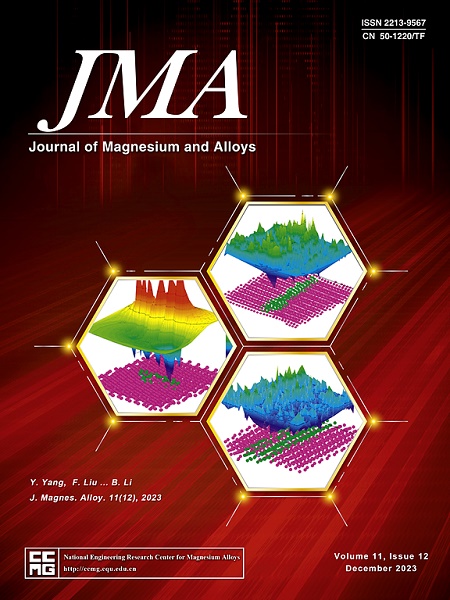界面声氧化反应诱导AZ31B与ZrO2在低温下直接成键
IF 15.8
1区 材料科学
Q1 METALLURGY & METALLURGICAL ENGINEERING
引用次数: 0
摘要
最近,金属陶瓷复合结构设计的提出为提高部件的使用性能提供了另一种思路,而传统的金属和陶瓷连接方法必须涉及高热量输入。然而,由于镁合金的熔点较低,镁合金-陶瓷连接系统需要较低的连接温度。超声波振动可在固体基体中诱发大量缺陷,从而在低温下有效促进固相界面之间的原子扩散和冶金结合。因此,超声波辅助键合是一种非常有前景的方法,可在不使用中间膜的情况下实现金属和陶瓷之间快速可靠的连接。在这项研究中,AZ31B 合金与 ZrO2 陶瓷在 200 °C 下成功实现了直接粘接。在 AZ31B 与 ZrO2 的界面上发现了平均厚度为 55 nm 的多晶尖晶石 MgAl2O4。接头的平均剪切强度达到了 30.47 兆帕。此外,还对 AZ31B 的动态再结晶和 ZrO2 在接合过程中的耗氧行为进行了表征,以说明超声振动对接合的贡献。因此,提出了固体界面超声氧化反应,以详细讨论接头的结合机理。本文章由计算机程序翻译,如有差异,请以英文原文为准。

Direct bonding of AZ31B and ZrO2 induced by interfacial sono-oxidation reaction at a low temperature
Recently, the presentation of the metal-ceramic composite structure design provides an alternative idea for the improvement of components service performance, while conventional methods for joining metals and ceramics have to involve a high heat input. However, due to the low melting point of magnesium alloys, the magnesium alloys-ceramics joining system necessitates a low joining temperature. Ultrasonic vibrations can induce numerous defects in the solid matrix, which can effectively promote atomic diffusion and metallurgical bonding between solid-phase interfaces at low temperatures. Thus, ultrasonic-assisted bonding is a highly promising method for achieving rapid and reliable joining between metals and ceramics without the use of interlayers. In this study, the direct bonding of AZ31B alloy with ZrO2 ceramic was successfully achieved at 200 °C. A polycrystal spinel MgAl2O4 with an average thickness of 55 nm was identified at the AZ31B/ZrO2 interface. The average shear strength of joints reached 30.47 MPa. Furthermore, the dynamic recrystallization of AZ31B and the oxygen-depletion behavior of ZrO2 during the bonding process were characterized to illustrate the contribution of ultrasonic vibration to joint bonding. Consequently, the solid interfacial sono-oxidation reaction is proposed to discuss the bonding mechanism of the joint in detail.
求助全文
通过发布文献求助,成功后即可免费获取论文全文。
去求助
来源期刊

Journal of Magnesium and Alloys
Engineering-Mechanics of Materials
CiteScore
20.20
自引率
14.80%
发文量
52
审稿时长
59 days
期刊介绍:
The Journal of Magnesium and Alloys serves as a global platform for both theoretical and experimental studies in magnesium science and engineering. It welcomes submissions investigating various scientific and engineering factors impacting the metallurgy, processing, microstructure, properties, and applications of magnesium and alloys. The journal covers all aspects of magnesium and alloy research, including raw materials, alloy casting, extrusion and deformation, corrosion and surface treatment, joining and machining, simulation and modeling, microstructure evolution and mechanical properties, new alloy development, magnesium-based composites, bio-materials and energy materials, applications, and recycling.
 求助内容:
求助内容: 应助结果提醒方式:
应助结果提醒方式:


